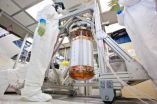(Press-News.org) PROVIDENCE, R.I. [Brown University] — A new high-accuracy calibration of the LUX (Large Underground Xenon) dark matter detector demonstrates the experiment's sensitivity to ultra-low energy events. The new analysis strongly confirms the result that low-mass dark matter particles were a no-show during the detector's initial run, which concluded last summer.
The first dark matter search results from LUX detector were announced last October. The detector proved to be exquisitely sensitive, but found no evidence of the dark matter particles during its first 90-day run, ruling out a wide range of possible models for dark matter particles. Previous experiments had detected potential signatures of dark matter particles with a very low mass, but LUX turned up no such signal. This latest work was focused on demonstrating the high sensitivity of LUX to potential signals in the search for those low-mass particles.
"The new calibration improved our calibration accuracy by about a factor of 10," said Rick Gaitskell, professor of physics at Brown and co-spokesperson for LUX. "It demonstrates that our first dark matter search result, which showed no sign of low-mass particles, is absolutely robust."
The results of the new analysis were presented Wednesday, Feb. 19, 2014, at the Lake Louise Winter Institute in Alberta, Canada, by James Verbus, a graduate student at Brown who led the new calibration work.
Dark matter is thought to account for about 80 percent of the mass of the universe. Though it has not yet been detected directly, its existence is a near certainty among physicists. Without the gravitational influence of dark matter, galaxies and galaxy clusters would simply fly apart into the vastness of space. It's not clear exactly what dark matter is, but the leading idea is that it consists of subatomic particles called WIMPs, short for weakly interacting massive particles. WIMPs are thought to be practically ubiquitous in the universe, but because they interact so rarely with other forms of matter, they generally pass right through the earth and everything on it without anyone knowing it.
The LUX is designed to detect those rare occasions when a WIMP does interact with other forms of matter. The detector consists of a third of a ton of supercooled xenon in a tank festooned with light sensors, each capable of detecting a single photon at a time. As WIMPs pass through the tank, they should, on very rare occasions, bump into the nucleus of a xenon atom. Those bumps cause the nucleus to recoil, creating a tiny flash of light and an ion charge, both of which are picked up by LUX sensors. The detector is more than a mile underground at the Sanford Underground Research Facility in South Dakota, where it is shielded from cosmic rays and radiation that might interfere with a potential dark matter signal.
This latest work was an entirely new way of calibrating the detector to recognize a WIMP signal.
"One of the important things we need to do is to calibrate the detector for what a WIMP-like recoil would look like," Verbus said. "You want to be able to measure your detector response for WIMP-like events."
To do that, the scientists use neutrons as a stand-in for WIMPs. The recoil created when a neutron hits the nucleus of a xenon atom is thought to be very similar to the recoil that would be created by a WIMP. To calibrate the LUX for low-mass WIMPS, the LUX team fired low-mass neutrons directly into the detector and used the detector's instruments precisely measure the characteristics of the neutron recoil. Once the researchers established exactly what a low-mass neutron recoil looks like, they went back to their data from the dark matter search to see if similar events occurred.
What makes this calibration method unique is that it was done directly inside the LUX detector. In previous xenon experiments, the neutron calibrations were done in separate test chambers instead of in the detector itself.
"Because our detector is so big and detects recoil positions so well," Verbus said, "we can just fire neutrons directly into LUX and get an absolute measurement of energy."
The LUX team used this new calibration to double-check the data from the detector's first run. Those initial results were confirmed: There were no low-mass WIMP events in the first run.
Along with the low-mass wimps, the first 90-day run of LUX ruled out a wide swath of possibilities for what dark matter could be made of. "There are literally thousands of models of particle physics lying bloodied in the gutter," Gaitskell said of the detector's first results.
LUX will expand its search later this year when it begins a second, year-long run searching for new dark matter models at an even greater sensitivity.
INFORMATION:
Editors: Brown University has a fiber link television studio available for domestic and international live and taped interviews, and maintains an ISDN line for radio interviews. For more information, call (401) 863-2476.
New calibration confirms LUX dark matter results
2014-02-20
ELSE PRESS RELEASES FROM THIS DATE:
Better broccoli, enhanced anti-cancer benefits with longer shelf life
2014-02-20
URBANA, Ill. – While researching methods to increase the already well-recognized anti-cancer properties of broccoli, researchers at the University of Illinois also found a way to prolong the vegetable's shelf life.
And, according to the recently published study, the method is a natural and inexpensive way to produce broccoli that has even more health benefits and won't spoil so quickly on your refrigerator shelf.
Jack Juvik, a U of I crop sciences researcher, explained that the combined application of two compounds, both are natural products extracted from plants, increased ...
Smaller meals more times per day may curb obesity in cats
2014-02-20
URBANA, Ill. – Just as with people, feline obesity is most often linked to excessive food intake or not enough physical activity. Attempts to cut back on calories alone often result in failed weight loss or weight regain in both people and their pets.
So how do you encourage your cat to get more exercise?
Researchers from the University of Illinois interested in finding a method to maintain healthy body weight in cats, looked at a previously suggested claim that increased meal frequency could help to increase overall physical activity.
The idea is to feed cats the ...
Color vision problems become more common with age, reports Optometry and Vision Science
2014-02-20
Philadelphia, Pa. (February 20, 2014) - Abnormal color vision increases significantly with aging—affecting one-half or more of people in the oldest age groups, reports a study in Optometry and Vision Science, official journal of the American Academy of Optometry. The journal is published by Lippincott Williams & Wilkins, a part of Wolters Kluwer Health.
While few people younger than 70 have problems with color vision, the rate increases rapidly through later decades of life, according to the new research by Marilyn E. Schneck, PhD, and colleagues of The Smith-Kettlewell ...
Roots to shoots: Hormone transport in plants deciphered
2014-02-20
Plant growth is orchestrated by a spectrum of signals from hormones within a plant. A major group of plant hormones called cytokinins originate in the roots of plants, and their journey to growth areas on the stem and in leaves stimulates plant development. Though these phytohormones have been identified in the past, the molecular mechanism responsible for their transportation within plants was previously poorly understood.
Now, a new study from a research team led by biochemist Chang-Jun Liu at the U.S. Department of Energy's (DOE) Brookhaven National Laboratory identifies ...
New research shows the way a room is lit can affect the way you make decisions
2014-02-20
The next time you want to turn down the emotional intensity before making an important decision, you may want to dim the lights first.
A new study from the University of Toronto Scarborough shows that human emotion, whether positive or negative, is felt more intensely under bright light. Alison Jing Xu, assistant professor of management at UTSC and the Rotman School of Management, along with Aparna Labroo of Northwestern University, conducted a series of studies to examine the unusual paradox of lighting and human emotion.
"Other evidence shows that on sunny days people ...
Recurrent mouth and throat cancers less deadly when caused by virus, study shows
2014-02-20
People with late-stage cancer at the back of the mouth or throat that recurs after chemotherapy and radiation treatment are twice as likely to be alive two years later if their cancer is caused by the human papillomavirus (HPV), new research led by a Johns Hopkins scientist suggests.
Previous studies have found that people with so-called HPV-positive oropharyngeal cancers are more likely to survive than those whose cancers are related to smoking or whose origins are unknown.
The new study, scheduled to be presented Feb. 20 at the 2014 Multidisciplinary Head and Neck ...
Humidification of the mouth, throat during RT for head and neck cancer reduces mucositis, hospital stay
2014-02-20
Scottsdale, Ariz., February 20, 2014—Patients who received daily humidification of the mouth and throat region beginning from day one of radiation therapy treatment spent nearly 50 percent fewer days in the hospital to manage their side effects, according to research presented today at the 2014 Multidisciplinary Head and Neck Cancer Symposium.
The study was conducted by the Trans Tasman Radiation Oncology Group and evaluated 210 head and neck cancer patients in New Zealand and Australia from June 2007 through June 2011. Patients in this Phase III trial were randomized ...
HPV-positive OPSCC patients nearly twice as likely to survive as HPV-negative patients
2014-02-20
Scottsdale, Ariz., February 20, 2014—A retrospective analysis of oropharyngeal patients with recurrence of disease after primary therapy in the Radiation Therapy Oncology Group (RTOG) studies 0129 or 0522 found that HPV-positive patients had a higher overall survival (OS) rate than HPV-negative patients (at two years post-treatment, 54.6 percent vs. 27.6 percent, respectively), according to research presented today at the 2014 Multidisciplinary Head and Neck Cancer Symposium.
The analysis included 181 patients with stage III-IV oropharyngeal squamous cell carcinoma (OPSCC) ...
HPV-positive SCCOP patients' recurrence differs from HPV-negative patients
2014-02-20
Scottsdale, Ariz., February 20, 2014—Patients with HPV-positive squamous cell carcinoma of the oropharynx (SCCOP) had a longer time to development of distant metastasis (DM) after initial treatment, and had more metastatic sites in more atypical locations compared to HPV-negative patients, according to research presented today at the 2014 Multidisciplinary Head and Neck Cancer Symposium.
Culled from records of an IRB-approved registry, the study reviewed 285 patients with stage III-IV SCCOP (originally thought to be a smoking-related head and neck cancer) treated with ...
Feasible, safe to limit radiation to major salivary glands in head and neck cancer patients
2014-02-20
Scottsdale, Ariz., February 20, 2014—Avoiding the contralateral submandibular gland during radiation therapy is feasible and safe with advanced stage, node positive head and neck cancers and base of tongue lesions, according to research presented today at the 2014 Multidisciplinary Head and Neck Cancer Symposium.
Researchers conducted a retrospective analysis of 71 patients from two facilities—the University of Colorado Cancer Center and the Memorial Sloan-Kettering Cancer Center. The median patient age was 55, and about 50 percent of the patients were current or former ...

